History
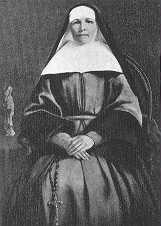
Mademoiselle Louise Brulois, who became Sr. Augustine
The roots of Joseph & Mary’s Home were planted in 1851 when the Sisters of Charity of St. Augustine (CSA) arrived in Cleveland from France to serve as the city’s first public health nurses. The first CSA sisters quickly went to work serving the health, human service and educational needs of Cleveland’s most impoverished and vulnerable residents.
For more than 165 years, the Sisters of Charity of St. Augustine have worked to address the root causes of poverty and meet the physical, spiritual, emotional and collective needs of the communities they serve. As time passes and communities change, the sisters adapt their ministries to meet new and emerging needs.
The Dream Team
In the mid-1990s, the Sisters of Charity of St. Augustine established “The Dream Team”—a group of eight CSA sisters—to create proposals for projects to respond to a variety of pressing societal needs.
During the review of various proposals by the Dream Team, Sister Ruth Ann Patrick, CSA, a social worker at St. Vincent Charity Medical Center, brought to light the needs of those experiencing homelessness—particularly those who had been discharged from the hospital and have nowhere to stay during their recovery from illness and/or surgery.
This need rapidly captured the passion of the committee, who decided to begin researching resources currently available to those experiencing homelessness in Cleveland, as well as models of service in other cities. Sister Ruth Ann surveyed social workers in area hospitals and other health care agencies to increase understanding of the health care needs of men experiencing homelessness.
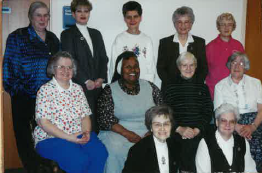
The “Dream Team” pose for a photo during a Joseph’s Home planning meeting
Guided by the results of their research, the committee began to develop a vision of how to respond to this critical need in the community. Due to the unmet needs they saw and the distribution of resources already available, they chose to focus on meeting the needs men experiencing homelessness from a location near downtown or on the west side. The Dream Team then took the critical steps of selecting a site and evaluating funding opportunities.
In July 1997, the Sisters of Charity of St. Augustine approved the incorporation of Joseph’s Home. Sisters Joan Gallagher, Evelyn Flowers and Ruth Ann Patrick were temporary incorporators and initial trustees.
In 1998 and 1999, the sisters took significant strides toward making their dream a reality. They secured the use of land and a building owned by St. Vincent Charity Medical Center, as well as money for renovation and initial working capital. But, the project gained real momentum when the Joseph’s Home trustees received a letter from United States Department of Housing and Urban Development informing them that Joseph’s Home had been selected for funding as a project to help medically fragile men experiencing homelessness move to self-sufficiency and permanent housing.
A board of directors for Joseph’s Home was appointed in October 1999. Sisters Joan Gallagher, Regina Fierman, Theresa Bontempo and Evelyn Flowers were among the founding members.
Sister Joan stepped into her position as director effective January 10, 2000. Sister Regina, a certified occupational therapy assistant and member of the original Dream Team, joined the staff as house monitor and resident educator.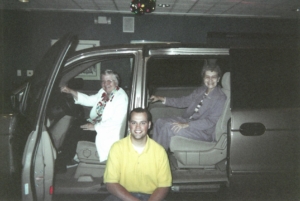
Committee members continued preparing the building for use until the formal opening in May 2000. As the building was being finished, a comprehensive program was also constructed. Goals for each participant’s time in the program were to include items such as obtaining permanent housing, improving his health status, obtaining a GED, developing job skills and preparing to enter the workforce. To make these goals attainable, medical services, life skills education, employment opportunities, transitional housing options and other support services would be provided through partnerships with other health and social service organizations.
Grand Opening: April 30, 2000
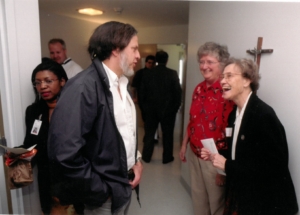
Sr. Joan greets guests at the blessing of Joseph’s Home in April 2000
On April 30, 2000, the Sisters of Charity of St. Augustine, along with their associates and friends, held an open house and formal blessing of the facility. The mission statement composed for the founding was:
Joseph’s Home opened as a transitional facility to provide health care to adults experiencing homelessness with temporary or chronic illnesses. While recuperating from their illnesses, the residents would participate in activities of daily living, educational activities that foster self-esteem, self-starting goals, life skills and an ongoing recovery program.
The missioning and anointing of Sister Joan and staff took place June 28, 2000. On August 3, 2000, the first resident arrived. Since that day, hundreds of men have passed through the doors of Joseph’s Home.
The success of Joseph’s Home is evidenced by a significant majority of residents leaving with a renewed sense of self, a place to call home, stabilized health conditions, and educational and job opportunities. Each year, approximately 40 to 50 men are served, with a capacity of 11 men at any given time.
Sister Joan retired as executive director in December 2005, and was followed by multiple laypeople who served as executive directors. Sister Regina continued in her role as house manager until she was elected to leadership in the Sisters of Charity of St. Augustine in 2009. Participation by the Sisters of Charity of St. Augustine on the Joseph’s Home Board of Directors continues to this day.
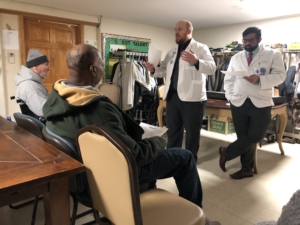
Pharmacy students give a presentation about medication literacy and compliance to Joseph’s Home residents
Transitioning to a Medical Respite Model
Since its inception until 2016, Joseph’s Home served the community as a transitional housing provider offering medical care for acutely ill men experiencing homelessness. This strategy helped hundreds of men stabilize their health and secure stable housing.
Although this approach had historically been effective for constituents, leadership and staff began to notice the needs of the community evolving. Medical conditions for those experiencing homelessness became more complex, exceeding the staff’s capacity. With more complex problems, discharges to permanent housing became less likely, and often inappropriate, as many residents needed a higher level of care.
At the same time, the homeless continuum and nationally recommended best practices for helping the community of people experiencing homelessness also began to change. A greater emphasis was placed on permanent supportive housing programs, while transitional housing programs began to emphasize specialty services such as addiction treatment, employment training, or, in the case of Joseph’s Home, medical care.
Understanding the importance of the Joseph’s Home program to the community, as well as the growing need for more clinical offerings for people experiencing homelessness, leadership and staff began investigating the possibility of transitioning Joseph’s Home to a medical respite program.
After much research, the decision was made that Northeast Ohio needed a medical respite program offering temporary housing to medically fragile men experiencing homelessness. In 2016, the transition to a medical respite program began based on best practices as identified by federal, state and local policymakers and organizations focused on medical respite and homelessness. Primary changes included creating staff efficiencies by eliminating positions suited for a transitional housing model. Instead, those positions were replaced with more clinically competent positions. Length of stay for residents was also reduced to address the need for more medical respite beds in the community.
